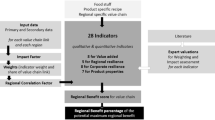Abstract
Goal, Scope and Background
Obviously, people assume that the regional production and distribution of food requires less energy turnover, compared with global transports of food. Politicians claim the term “regionality”, maintaining that regionality is a medicine against wasting so much energy for the global food distribution. Additionally the energy turnover is causing pollution. But remarkably, there is a lack of empirical data to support this idea. At the same time, nobody really requires regional origin for non-food items, e.g. for bicycles, dishwashers, furniture or cars etc. The public mainstream asks for regional origin merely for food. Hence, the first scientific issue worked out in this paper is how the energy turnover of comparable food items can be measured, regarding the lifecycle of food in total. That means to investigate the partial systems of crop or breed, of food production, of packaging including transport and distribution up to the point of sale. Secondly, it has to be checked, if the assumed coincidence of low energy turnover and regional origin can be verified. The specific energy turnover, calculated in the unit [kWh per kg] or [kWh per l] of food, is investigated by comparing regional with global process chains for different food items. Two examples of food – fruit juices and lamb meat – are researched, by personal investigation worldwide. Firstly, fruit juices of high grade quality from Brazil, from European origin and from local German farmers are compared, in terms of energy. Secondly, a comparison of lamb meat from New Zealand and lamb meat from local German farmers is conducted. Lamb meat has been investigated, because it is shipped around the world as frozen natural food, not concentrated like juices. In addition, the business size of the food producers is researched for both examples.
Methods
As a part of LCA the energy turnover of each process step from the very beginning up to the point of sale is investigated. These primary results are the basic empirical data, in order to allocate the energy turnover at the food items as functional units. The results of regional, European-continental and of global process chains are compared. In addition, the issue is investigated, whether the specific energy turnover depends upon the business size.
Results and Discussion
Surprisingly, the data in both cases demonstrate a strong degressive relation of the specific energy turnover and the business size. Here it is not important, if the business is regional or not. Merely the efficiency and logistics of the production and the operations determine the specific energy turnover. These findings seem closely connected with the business size, because small companies are not able to invest in energy recovering and saving technology. The regional juices business is worsened by the huge number of smallsized transports of the crop and the nearly bottle-wise distribution. Regarding lamb meat we once more find the disadvantages of comparably small farms again. In addition, the German farmers need daily shepherds, fences by night, stables and usually additional feed during the wintertime. All these efforts are not necessary in New Zealand, where the climatic conditions and the open countryside with low population allow rather easy and low energy breeding of lamb.
Conclusion
The coincidence of economic and ecological facts is obvious. As a matter of fact, in economics there is a strong degressive relation between the production costs and the number of produced items. This relation is very well known as “Economy of Scale.” Our findings lead to similar conclusions, in terms of ecology. That means, the production ecology depends on the number of produced items. Additionally, our results demonstrate a minimum business size, so that we can claim an “Ecology of Scale” as well. However, on the other hand, the reported data and the conclusions are valid for the investigated food items – fruit juices and lamb meat – only. Nevertheless, one conclusion is already evident: The most popular claims for regional food production and distribution instead of global process chains are not generally valid. Small farmers basically need much more energy to produce and distribute their products, compared with bigger units. Both food items demonstrate clearly, that the ecological quality is mainly influenced by the operational efficiency and not by the marketing distance itself.
Recommendation and Outlook
Much more detailed data of all the investigated operational units, processing fruit juices and lamb meat, have been published (Fleissner 2001). As a further example, we investigate wine from different countries as a further example. Different from fruit juices, which can be shipped as a concentrate, and different from lamb meat, which is shipped as frozen food, wine of high grade quality is always bottled close to the place of origin. That means, that not only the food, but also the heavy weight packaging is transported around the world. So, we are very curious about the results, which we expect for 2004.
Similar content being viewed by others
Author information
Authors and Affiliations
Corresponding authors
Rights and permissions
About this article
Cite this article
Schlich, E., Fleissner, U. The Ecology of Scale: Assessment of Regional Energy Turnover and Comparison with Global Food (5 pp). Int J Life Cycle Assessment 10, 219–223 (2005). https://doi.org/10.1065/lca2004.09.180.9
Received:
Accepted:
Published:
Issue Date:
DOI: https://doi.org/10.1065/lca2004.09.180.9




